Accepted Scientific Name: Mammillaria standleyi (Britton & Rose) Orcutt
Cactography 8. 1926 [ cf: Gentry - Publ. Carnegie Inst. Wash. No. 527 (Rio Mayo Pl.) 196 (1942). ] Orcutt
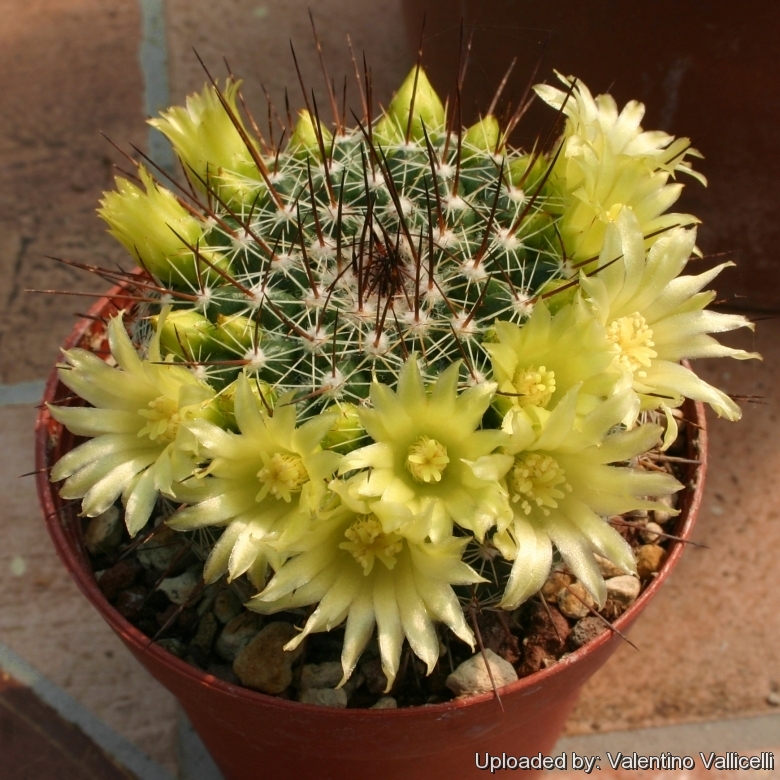
Mammillaria lindsayi Photo by: Valentino Vallicelli
After several years the plants branches from the base sometime forming very large clumps up to 1 m wide (space permitting!) but patience is required as it is also a fairly slow grower.
Origin and Habitat: Chihuahua ( Los Molinos, Sierra Colorado, Barranca de Cobre, La Reforma, etc.) and Sinaloa (Mazatlan, Culiacan, El Nacimiento, Potrero de Cancio, Zapote de Madriles, Presa Huites, etc.), Mexico.
Altitude: 250-2000 metres above sea level.
Habitat: Grows in partial shade of canyon walls or rocky slopes, in leaf-mould in cracks in the rocks, in foothill thorn scrubs, in low dry forest and in pine-oak woodlands.
Synonyms:
See all synonyms of Mammillaria standleyi
back
Accepted name in llifle Database:Mammillaria standleyi (Britton & Rose) OrcuttCactography 8. 1926 [ cf: Gentry - Publ. Carnegie Inst. Wash. No. 527 (Rio Mayo Pl.) 196 (1942). ]Synonymy: 24
back
Description: Mammillaria lindsayiSN|9417]]SN|20796]] is solitary or cespitose cactus branching from base, sometime forming very large clumps up to 1 m wide. Some authors consider this species only a form of the widespread an very variable Mammillaria standleyiSN|20796]]SN|9417]].
Stem: Symmetrically globose, depressed, with apex that often appears completely white, grey green, 12-15 cm high and in diameter. With latex.
Tubercles: Conical to quadrangular, keeled, arranged in numerous, close-set spirals. (Parastichy number 13-21) with dense white axillary wool and up to 8 white, twisted bristles.
Areoles: Oval and with white wool when young.
Radial spines: 10-14, white with tan to golden yellow bases, 2 - 8 mm long, upper ones shortest.
Central spines: 2-4 , straight, acicular/subulated, rigid, divergent, golden brown, reddish to almost black, the 2-3 uppermost short (approx 4 mm long) long, The lowermost longest 4 - 12 mm long (or more).
Flowers: Small, funnelform, 15 - 20 mm long, to 10 mm in diameter, light greenish yellow with orange-yellow midveins, .
Fruits: Club shaped to cylindrical, attractively deep coloured dull pinkish-red to scarlet, up to 20 mm long and 2 - 3 mm wide. .
Seeds: Brown.
Subspecies, varieties, forms and cultivars of plants belonging to the Mammillaria standleyi group
 Mammillaria floresii Fritz Schwarz: usually solitary. Central spines (2-)4, reddish 5-9 mm long. Radials few to 16, 4-8 mm long. Flowers purplish red to 12 mm long. Distribution: San Bernardo, Sonora.
Mammillaria floresii Fritz Schwarz: usually solitary. Central spines (2-)4, reddish 5-9 mm long. Radials few to 16, 4-8 mm long. Flowers purplish red to 12 mm long. Distribution: San Bernardo, Sonora. Mammillaria lindsayi R.T.Craig: forms clumps up to 1 m wide, has white axillary wool and bristles. Radial spines 10-14 white, centrals 2-4 , straight, brown to black, flowers greenish yellow. Distribution: Chihuahua and Sinaloa, Mexico.
Mammillaria lindsayi R.T.Craig: forms clumps up to 1 m wide, has white axillary wool and bristles. Radial spines 10-14 white, centrals 2-4 , straight, brown to black, flowers greenish yellow. Distribution: Chihuahua and Sinaloa, Mexico. Mammillaria lindsayi var. cobrensis Repp.: is distinguishable from the type for the stem that is always solitary with a very woolly apex. The stem is dark green and it lacks of bristles in the woolly tubercles axil. Distribution: Barranca del Cobre, Chihuahua, Mexico.
Mammillaria lindsayi var. cobrensis Repp.: is distinguishable from the type for the stem that is always solitary with a very woolly apex. The stem is dark green and it lacks of bristles in the woolly tubercles axil. Distribution: Barranca del Cobre, Chihuahua, Mexico.- Mammillaria lindsayi var. rubriflora Hils: as the name implies it has reddish flower.
 Mammillaria miegiana W.H.Earle: mostly solitary with stems, densely covered by spines appearing white and producing large, dark reddish-pink flowers with scarlet midveins. Distribution: Northem Sonora.
Mammillaria miegiana W.H.Earle: mostly solitary with stems, densely covered by spines appearing white and producing large, dark reddish-pink flowers with scarlet midveins. Distribution: Northem Sonora. Mammillaria standleyi (Britton & Rose) Orcutt: very variable, with white radial spine, brownish centrals and white wool between the tubercles. Flowers purplish up to 12 mm long. Distribution: Chihuahua, Sinaloa, and Sonora.
Mammillaria standleyi (Britton & Rose) Orcutt: very variable, with white radial spine, brownish centrals and white wool between the tubercles. Flowers purplish up to 12 mm long. Distribution: Chihuahua, Sinaloa, and Sonora.
Bibliography: Major references and further lectures
1) Pilbeam J., “The Cactus file, Mammillaria” 6: 120, Cirio Pub. Services, 01/Dec/1999
2) John Pilbeam “Cacti for the Connoisseur: A Guide for Growers & Collectors” Timber Press, 01/lug/1987
3) James Cullen, Sabina G. Knees, H. Suzanne Cubey "The European Garden Flora Flowering Plants: A Manual for the Identification of Plants Cultivated in Europe, Both Out-of-Doors and Under Glass" Cambridge University Press, 11/Aug/2011
4) David R Hunt; Nigel P Taylor; Graham Charles; International Cactaceae Systematics Group. "The New Cactus Lexicon" dh books, 2006
5) Edward Anderson “The Cactus family” Timber Press, Incorporated, 2001
6) Burquez Montijo, A. & Felger, R.S. 2013. Mammillaria standleyi. In: IUCN 2013. "IUCN Red List of Threatened Species." Version 2013.2. <www.iucnredlist.org>. Downloaded on 13 January 2014.
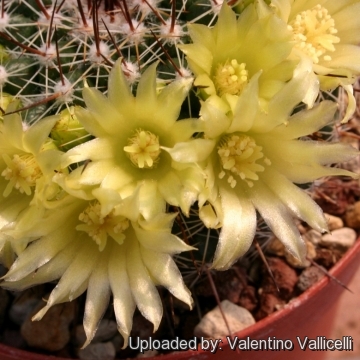 Mammillaria lindsayi Photo by: Valentino Vallicelli
Mammillaria lindsayi Photo by: Valentino Vallicelli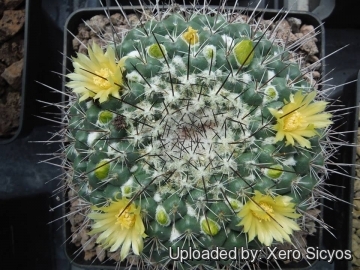 Mammillaria lindsayi Photo by: Xero Sicyos
Mammillaria lindsayi Photo by: Xero Sicyos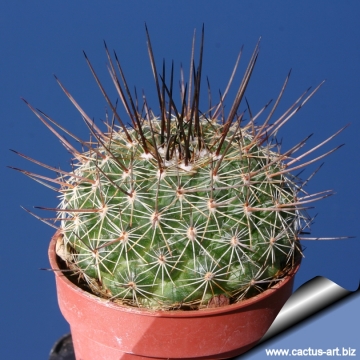 Mammillaria lindsayi Photo by: Cactus Art
Mammillaria lindsayi Photo by: Cactus Art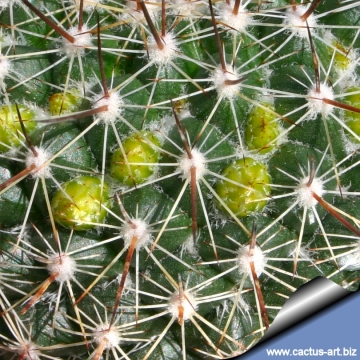 Mammillaria lindsayi Photo by: Cactus Art
Mammillaria lindsayi Photo by: Cactus Art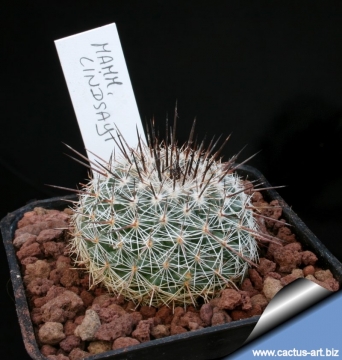 Mammillaria lindsayi Photo by: Cactus Art
Mammillaria lindsayi Photo by: Cactus Art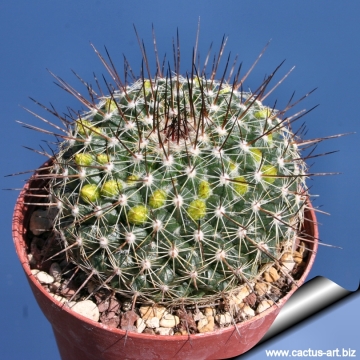 Mammillaria lindsayi Photo by: Cactus Art
Mammillaria lindsayi Photo by: Cactus ArtCultivation and Propagation: This plant is easy to cultivate but very slow growing. Cultivate it in a well drained and mineral substratum. Water regularly, avoid the use of peat or other humus sources in the potting mixture. It need full sun, so it keep a compact and flat shape. It does not tolerate intense cold, but tolerates some cold if kept dry. Frequent transplantations of the young plants protect the lower part of the stem from the lignification, to which the plant has a tendency.
Reproduction: It is propagated by seed. Sometimes old plants forms large clumps with several joints - but the removal of one of these joints may prove fatal to the plant.

















